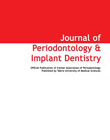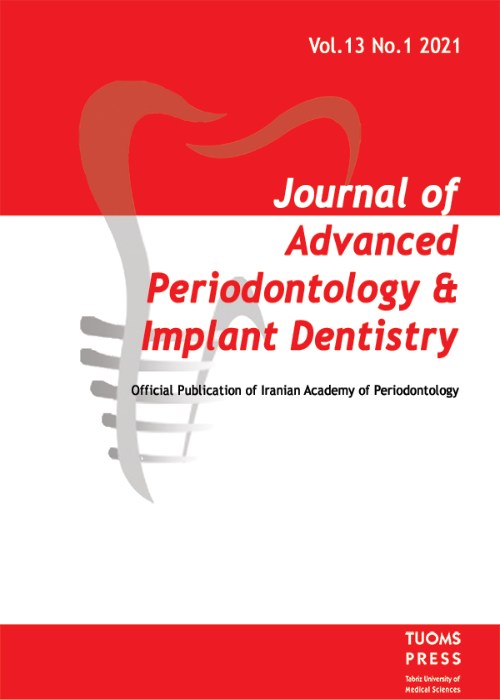فهرست مطالب

Journal of Advanced Periodontology and Implant Dentistry
Volume:6 Issue: 1, Jun 2014
- تاریخ انتشار: 1393/02/23
- تعداد عناوین: 6
-
-
Pages 3-7Background And AimsDespite the very good results, implant treatment has also been associated with some failures. The aim of this study was to evaluate the success rate, survival rate, and tissue health indices around XiVE® dental implants placed in patients in a dental office in Isfahan.Materials And MethodsIn this cross-sectional study, 129 XiVE® dental implants were selected. A form was prepared by two periodontists for the collection of demographic information and assessment of soft- and hard-tissue health at the implant sites. Data were analyzed by t-test and the Wilcoxon test with SPSS20 statistical software; p = 0.05 was considered statistically significant.ResultsOf the 129 implants, 57.3% were in males and 42.7% in females; of the total, 47.3% were maxillary, 52.7% mandibular, and 17.8% were single- and 82.2% multi-unit. Periodontal indices, except probing depth, were significantly lower around maxillary implants (p < 0.05). There was no statistically significant difference between the left and right jaws in terms of periodontal index (p > 0.05). In all cases, the periodontal indices of dental implants were lower than those of the teeth and showed 100% success and survival rates.ConclusionThe results of this study showed 100% success and 2-year survival rates with XiVE® implants with healthy tissues surrounding the implants.Keywords: Dental Implants, survival rate, dental tissue conditioning
-
Pages 8-12Background And AimsPain control ensures patient satisfaction and cooperation. This study aimed to compare the interseptal anesthetic technique (IA) as the initial injection for pain control during periodontal flap surgery with the inferior alveolar nerve block (IANB) accompanied by long buccal infiltration (LBI).Materials And MethodsThis single-blind randomized clinical trial included 40 periodontitis patients. Pain intensity was evaluated immediately after injection and at the end of surgery. One side was chosen as the control to receive IANB accompanied by LBI and the other side as the test to receive IA. After the injection, the patients were asked to mark their reaction to the pain immediately after the injection on a visual analogue scale, which was repeated to analyze pain the day after surgery. Data were analyzed with independent-samples t-test using SPSS 13. Statistical significance was set at P < 0.05.ResultsThe mean pain scores immediately after injection in the control and test groups were 20.62 ± 7.62 and 21.47 ± 8.62, respectively, with no statistically significant difference (df = 78, t = −0.466, P = 0.642). Pain scores 24 hours after completion of surgery in the control and test groups were 7.97 ± 3.43, and 9.30 ± 3.24, respectively, with no significant difference (df = 78, t = −1.775, P = 0.080).ConclusionBased on the results, interseptal anesthetic technique was not shown to be superior to conventional injections.Keywords: Anesthesia, injection, pain
-
Pages 13-17Background And AimsChanges in the balance of sexual hormones during pregnancy decrease gingival crevicular fluid levels of interleukin-6 and the resistance of gingival tissue against inflammations. Hormonal contraceptives are agents that are based on the effects of gestational hormones and simulate a state of pregnancy; therefore, they prevent ovulation. This study evaluates the effect of these drugs on periodontal tissues and levels of IL-6 in gingival crevicular fluid.Materials And MethodsTwenty-five patients who had not used oral contraceptives (control) and 35 patients using oral contraceptives (case) were examined clinically and their medical history, dosage and duration of oral contraceptives use were recorded. Periodontal indices such as bleeding on probing, plaque index, probing pocket depth, clinical attach-ment loss and levels of IL-6 in gingival crevicular fluid were measured. Student’s t-test and Mann-Whitney test were used to analyze data.ResultsMann-Whitney test showed a statistically significant difference in the mean of bleeding on probing in the case and control groups (P)
-
Pages 18-22Background And AimsLocalized gingival recession presents as a special therapeutic problem. Subjective parameters and donor site morbidity are often overlooked while deciding on any treatment option.Materials And Methods22 subjects were equally divided in Group A (Lateral pedicle graft) and Group B (Free muco-sal graft). Subjective evaluation of post operative sensitivity, discomfort and bleeding at donor site, and patient perception of aesthetics was done.ResultsBoth groups showed the potential of achieving root coverage; however on comparison between the two groups, lateral pedicle flap showed improved patient perceived Quality of Life as compared to free mucosal graft, although clinical results were statistically non significant.ConclusionLateral pedicle graft is associated with less donor tissue morbidity and is well tolerated by the patient as compared to free mucosal graft.Keywords: Esthetics, Gingival recession, plastic surgery, Quality of life
-
Pages 23-27Background And AimPeriodontal disease is common among adults and is a potential source of chronic inflammation. Recent data have suggested an important role for chronic inflammation in the development of coronary heart disease (CHD). The purpose of this study was to address cardiologists’ knowledge regarding the effects of periodontal diseases on coronary heart system.Materials And MethodsA cross-sectional study was designed for cardiologists in Tabriz- Iran. A total of 54 cardiologists participated in the study. Each participant was given a self-administered questionnaire. It was a close ended questionnaire with responses presented as yes/no/don’t know choices. Data were analyzed using descriptive statistics.ResultsCardiologists’ knowledge about periodontal disease was moderate. Eighty two percent of cardiologists agreed that inflammation is a key component between periodontal disease and CHD.Seventy-six percent agreed that controlling infection and inflammation is important for managing CHD. 62 % of respondents reported not receiving any education on oral healthcare. 80 percent of cardiologists believe that medical and dental students should be trained to work collaboratively.ConclusionIt is important for educators and administrators in higher education to examine the need for interprofessional education and collaboration between medicine and dentistry.
-
Pages 28-34The Sturge-Weber syndrome or Encephalotrigeminal Angiomatosis is a rare neurological and congenital disorder with frequency of 1:50,000 births. This syndrome is nonhereditary developmental condition and is characterized by presence of congenital capillary malformation and hamartomatous vascular proliferation involving face (port-wine stain or facial birthmark), sometimes skull and the tissues of brain, jaws, oral soft and hard tissue and rarely other body organs. Seizures, mental retardation, and cortical calcification (tram-tracks) and congenital glaucoma may be seen in this syndrome. We report here a 40 year old female with sturge weber diagnosis that had been associated with bilateral cutaneous capillary malformation on her face, neck, hands and feet and also gingival enlargement.


